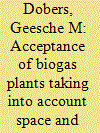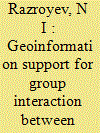| Srl | Item |
| 1 |
ID:
169876


|
|
|
|
|
| Summary/Abstract |
As part of Germany's energy transition, enormous efforts are being made to transform the German energy supply to renewable energies. While much of the energy supply from renewables is wind and solar power, biogas contributes on third position a considerable share due to substantial state subsidies. The transformation to renewable energies leads to notable landscape changes that should be taken into consideration when studying the acceptance of renewable energy plants. We do this by adding spatial information to data from an online survey (N = 942) questioning the acceptance of biogas plants. The density of and proximity to existing biogas plants as well as the intensity of maize cultivation in the vicinity of respondents is integrated into the analysis together with more conventional influencing factors such as place attachment and attitudes. Results show that attitudes have the strongest explanatory power but spatial variables, particularly maize intensity, contribute significantly, too. Place attachment does not show reliable effects. The results demonstrate that spatial data can be useful in the analysis of survey data, for instance, in an environmental context. They also show that diversification of the raw materials used for fermentation in biogas plants might be an important factor in improving their acceptance.
|
|
|
|
|
|
|
|
|
|
|
|
|
|
|
|
| 2 |
ID:
164240


|
|
|
|
|
| Summary/Abstract |
This paper looks at prerequisites of radical change in the existing system of topogeodetic support for combat actions, and also examines the prospects of replacing the notion topogeodetic support with geoinformation support, as well as defining the notion of geo-information support, its objectives and tasks.
|
|
|
|
|
|
|
|
|
|
|
|
|
|
|
|
| 3 |
ID:
161917


|
|
|
|
|
| Summary/Abstract |
The authors review the most topical problematic issues related to geoinformation support for military robotechnical complexes in real time, reveal their specific features and propose ways for solution.
|
|
|
|
|
|
|
|
|
|
|
|
|
|
|
|
| 4 |
ID:
183150


|
|
|
|
|
| Summary/Abstract |
This article introduces CShapes 2.0, a GIS dataset that maps the borders of states and dependent territories from 1886 through 2019. Our dataset builds on the previous CShapes dataset and improves it in two ways. First, it extends temporal coverage from 1946 back to the year 1886, which followed the Berlin Conference on the partition of Africa. Second, the new dataset is no longer limited to independent states, but also maps the borders of colonies and other dependencies, thereby providing near complete global coverage of political units throughout recent history. This article explains the coding procedure, provides a preview of the dataset and presents three illustrative applications.
|
|
|
|
|
|
|
|
|
|
|
|
|
|
|
|
| 5 |
ID:
182667


|
|
|
|
|
| Summary/Abstract |
Recent literature highlights the role of historical events in shaping contemporary political and economic outcomes. This article joins the growing debate by utilizing disaggregated data and mediation analysis to explore the causal mechanisms bridging ethnic partition by modern international borders and the risks of postcolonial civil conflicts in Africa. I argue that split ethnic groups are more likely to experience armed conflicts with the central government during the postcolonial age, and the conflict-escalating effect is particularly acute for large-sized split groups. When coupled with sizable demographic forces, ethnic partition heightens the political salience of the corresponding ethnic cleavage while generating greater information and commitment problems. The empirical results provide considerable support for the theoretical claim: first, ethnic partition increases the likelihood of armed conflicts between politically excluded ethnic groups and incumbent; and second, a major part of the conflict-escalating effect is attributable to the indirect and causal interaction effects induced by contemporary group size. The empirical analysis also reveals that the role of the primary alternative mechanism, political discrimination against split groups, in generating the historical treatment effect remains limited.
|
|
|
|
|
|
|
|
|
|
|
|
|
|
|
|